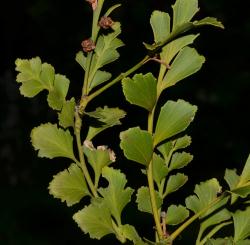- Taxon
- Gallery
Small trees up to 15(—25) m tall. Young or exposed plants conical in outline, shaded or enclosed plants with bushy, somewhat rounded, heavy crowns. Stems one or more, erect or leaning, strongly tapered, up to 90 cm diam., with regular coppice and epicormic shoots. Branches distinctly whorled, robust, suberect, horizontal, or downturned with upturned ends, leaving prominent rounded to elliptic branch scars when shed, and characteristic raised ridges encircling the stems. Outer bark brown, grey-brown, or silvery-brown, at first smooth or lenticellate, persistent, later vertically fissured with prominent rounded or irregular lenticels, often encrusted with lichens and bryophytes, and occasionally shedding in squarish or rectangular flakes; inner bark dark orange. Roots of mature trees plate-like, pegged, often with low rounded buttresses; mycorrhizal nodules or stub roots simple or branched, epidermal hairs abundant. Strong, erect, epicormic shoots from fallen layered stems. Cotyledons 2,12—20 × 2—3 mm, submembranous, linear, acute, green above, glaucous beneath, stomata on lower surface only, veins 2, spreading horizontally or drooping, often strongly curved and horseshoelike, persistent (Fig. 3). Juvenile leaves of seedlings and epicormic shoots 10—20 or more, 10—15 × 1— 2 mm, submembranous, linear and needle-like, acute or obtuse, sometimes falcate, green above, glaucous beneath, stomata on lower surface only, single veined; spreading horizontally or curved downwards, persistent (Fig. 3). Seedling phylloclades (flattened branch complex) 1.5-5 cm long, deeply pinnately lobed, determinate, subtended by juvenile leaves; transition to adult phylloclades gradual or rapid (Fig. 3). Adult phylloclades 5-20(-30) cm long, distinctly whorled, simple, or compound and pinnately lobed, determinate or indeterminate, subtended by scale leaves, each phylloclade consisting of 5—10 (—14) alternate, distichous, dorsiventral segments 2—4(—8) × 2—2.5(—4) cm, the segments very leathery, rhombic to flabellate with shallowly or deeply lobed or toothed, thickened, revolute margins, yellow-green, cup-shaped and amphistomatic when young, later flattened, green above, somewhat glaucous beneath, with stomata on lower surface only, subsessile or stalked (Fig. 2). Resting buds 5-20 × 3-10 mm, characteristically coated with a white resinous film, consisting of few to many scale leaves, the outermost 0.5-15 mm long, subulate, erect, loosely imbricate, at first green with stomata on the lower surface, later reddish, the innermost 10— 15 mm long on expansion, linear-obtuse to spathulate, at first green with stomata on the lower surface only, later reddish brown, deflexed and deciduous. Plants unisexual, with inconstant males and females. Male cones 5—20 in terminal whorled clusters (Fig. 4), 15—20(—30) × 5-10 mm at the widest point, cylindrical to wedge-shaped, each on a stout bracteate stalk 5—10(—15) mm long; sporophylls many, each with 2 sporangia; pollen monad with 2 small sacci. Female cones distichous on basal regions of phylloclades, or more rarely on phylloclade segments (Fig. 2, 5); 0.5-0.8 × 0.5 mm, ovoid to globose, each on a short stout bracteate stalk and consisting of few to many spirally arranged cone bracts; fertile bracts supporting a single, erect, sessile, flask-shaped ovule, arillate at base. Seeds 3-4 × 2.5—3 mm, ovoid to squarish, dorsiventrally compressed, nutlike, dark brown to almost black, protruding when mature, and surrounded at the base by a white, thinly fleshy, crenulate or erose aril; micropyle distinct, curved to the ventral side (Fig. 6). FLOWERING: October to December. Cone induction probably occurs in the preceding summer, as with most New Zealand conifers. Flowering is periodic in intensity and synchronous throughout the range of P. toatoa, although some plants in most populations will flower in any one year. Cultivated mature plants seem to flower annually. P. toatoa is wind pollinated and male trees produce copious amounts of pollen. Pollination is facilitated by the extension of a pollination drop through the micropylar orifice (Fig. 5; see also Tomlinson et al. 1991). FRUITING: January to March. Seeds develop rapidly and mature in the same season. Ripe seed is ejected from the cone by the swelling of cone bracts and much seed accumulates on the ground beneath female trees. Germination is epigeal and seeds germinate mainly in the second year after seed formation. Although seedlings are abundant beneath seed trees, the clumping of seedlings beneath perching trees and the establishment of seedlings over a wide area suggest that seed of P. toatoa is readily dispersed by birds (cf. Preest 1963).
[Reproduced from Molloy (1996, New Zealand J. Bot. 34: 287–297) with permission from The Royal Society of New Zealand.]




